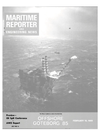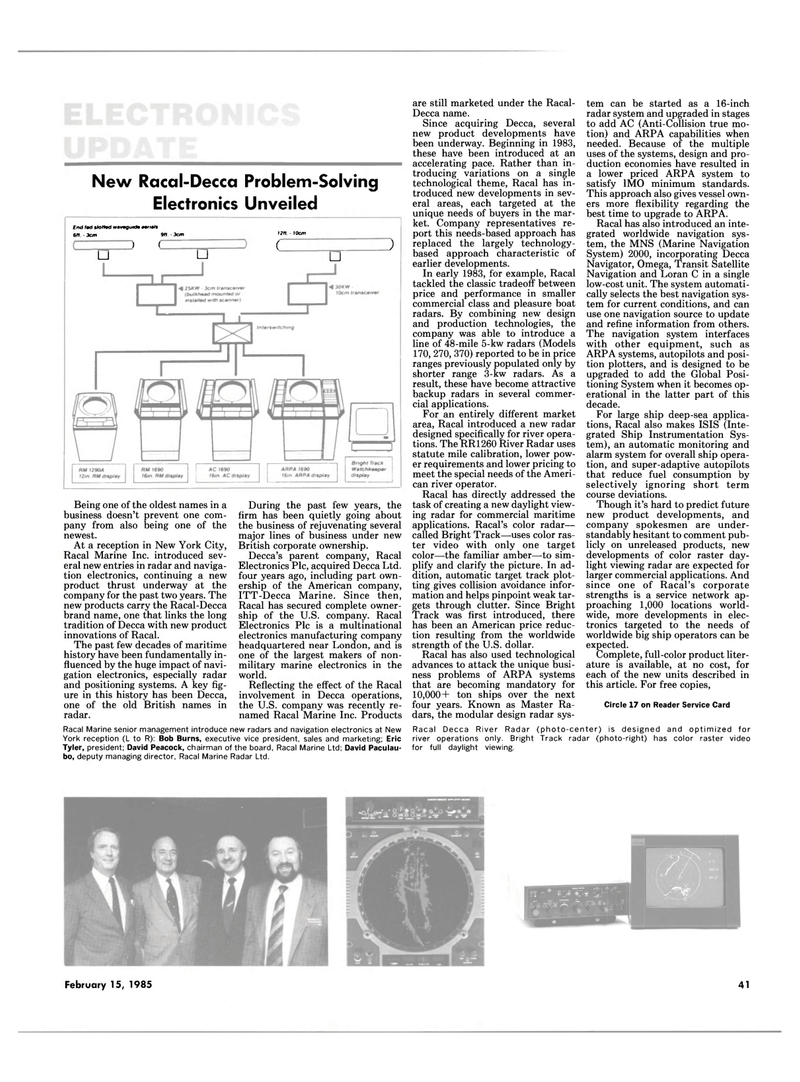
Page 41: of Maritime Reporter Magazine (February 15, 1985)
Read this page in Pdf, Flash or Html5 edition of February 15, 1985 Maritime Reporter Magazine
New Racal-Decca Problem-Solving
Electronics Unveiled
End t0d sioftvd wavqunto wts 6ft 3cm 9ft 3cm ) ( 12fl - 10cm
IT n c "IT D
Being one of the oldest names in a business doesn't prevent one com- pany from also being one of the newest.
At a reception in New York City,
Racal Marine Inc. introduced sev- eral new entries in radar and naviga- tion electronics, continuing a new product thrust underway at the company for the past two years. The new products carry the Racal-Decca brand name, one that links the long tradition of Decca with new product innovations of Racal.
The past few decades of maritime history have been fundamentally in- fluenced by the huge impact of navi- gation electronics, especially radar and positioning systems. A key fig- ure in this history has been Decca, one of the old British names in radar.
During the past few years, the firm has been quietly going about the business of rejuvenating several major lines of business under new
British corporate ownership.
Decca's parent company, Racal
Electronics Pic, acquired Decca Ltd. four years ago, including part own- ership of the American company,
ITT-Decca Marine. Since then,
Racal has secured complete owner- ship of the U.S. company. Racal
Electronics Pic is a multinational electronics manufacturing company headquartered near London, and is one of the largest makers of non- military marine electronics in the world.
Reflecting the effect of the Racal involvement in Decca operations, the U.S. company was recently re- named Racal Marine Inc. Products are still marketed under the Racal-
Decca name.
Since acquiring Decca, several new product developments have been underway. Beginning in 1983, these have been introduced at an accelerating pace. Rather than in- troducing variations on a single technological theme, Racal has in- troduced new developments in sev- eral areas, each targeted at the unique needs of buyers in the mar- ket. Company representatives re- port this needs-based approach has replaced the largely technology- based approach characteristic of earlier developments.
In early 1983, for example, Racal tackled the classic tradeoff between price and performance in smaller commercial class and pleasure boat radars. By combining new design and production technologies, the company was able to introduce a line of 48-mile 5-kw radars (Models 170, 270, 370) reported to be in price ranges previously populated only by shorter range 3-kw radars. As a result, these have become attractive backup radars in several commer- cial applications.
For an entirely different market area, Racal introduced a new radar designed specifically for river opera- tions. The RR1260 River Radar uses statute mile calibration, lower pow- er requirements and lower pricing to meet the special needs of the Ameri- can river operator.
Racal has directly addressed the task of creating a new daylight view- ing radar for commercial maritime applications. Racal's color radar— called Bright Track—uses color ras- ter video with only one target color—the familiar amber—to sim- plify and clarify the picture. In ad- dition, automatic target track plot- ting gives collision avoidance infor- mation and helps pinpoint weak tar- gets through clutter. Since Bright
Track was first introduced, there has been an American price reduc- tion resulting from the worldwide strength of the U.S. dollar.
Racal has also used technological advances to attack the unique busi- ness problems of ARPA systems that are becoming mandatory for 10,000+ ton ships over the next four years. Known as Master Ra- dars, the modular design radar sys- tem can be started as a 16-inch radar system and upgraded in stages to add AC (Anti-Collision true mo- tion) and ARPA capabilities when needed. Because of the multiple uses of the systems, design and pro- duction economies have resulted in a lower priced ARPA system to satisfy iMO minimum standards.
This approach also gives vessel own- ers more flexibility regarding the best time to upgrade to ARPA.
Racal has also introduced an inte- grated worldwide navigation sys- tem, the MNS (Marine Navigation
System) 2000, incorporating Decca
Navigator, Omega, Transit Satellite
Navigation and Loran C in a single low-cost unit. The system automati- cally selects the best navigation sys- tem for current conditions, and can use one navigation source to update and refine information from others.
The navigation system interfaces with other equipment, such as
ARPA systems, autopilots and posi- tion plotters, and is designed to be upgraded to add the Global Posi- tioning System when it becomes op- erational in the latter part of this decade.
For large ship deep-sea applica- tions, Racal also makes ISIS (Inte- grated Ship Instrumentation Sys- tem), an automatic monitoring and alarm system for overall ship opera- tion, and super-adaptive autopilots that reduce fuel consumption by selectively ignoring short term course deviations.
Though it's hard to predict future new product developments, and company spokesmen are under- standably hesitant to comment pub- licly on unreleased products, new developments of color raster day- light viewing radar are expected for larger commercial applications. And since one of Racal's corporate strengths is a service network ap- proaching 1,000 locations world- wide, more developments in elec- tronics targeted to the needs of worldwide big ship operators can be expected.
Complete, full-color product liter- ature is available, at no cost, for each of the new units described in this article. For free copies,
Circle 17 on Reader Service Card
Racal Marine senior management introduce new radars and navigation electronics at New Racal Decca River Radar (photo-center) is designed and optimized for
York reception (L to R): Bob Burns, executive vice president, sales and marketing; Eric river operations only. Bright Track radar (photo-right) has color raster video
Tyler, president; David Peacock, chairman of the board, Racal Marine Ltd; David Paculau- for full daylight viewing, bo, deputy managing director, Racal Marine Radar Ltd.
February 15, 1985 41

 40
40

 42
42
